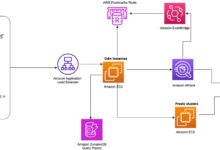AWS Management Console: 7 Powerful Features You Must Know
Ever felt overwhelmed managing cloud resources? The AWS Management Console simplifies everything with a powerful, intuitive interface that puts control at your fingertips. Whether you’re launching EC2 instances or monitoring S3 buckets, this web-based dashboard is your command center for AWS. Let’s dive into what makes it indispensable.
What Is the AWS Management Console?

The AWS Management Console is a web-based user interface provided by Amazon Web Services (AWS) that allows users to interact with and manage their AWS services and resources. Instead of relying solely on command-line tools or APIs, users can visually navigate, configure, monitor, and troubleshoot their cloud infrastructure through a graphical dashboard. It’s designed to be user-friendly, especially for those who are new to cloud computing or prefer a point-and-click experience over scripting.
Core Purpose and Functionality
The primary goal of the AWS Management Console is to provide a centralized access point for all AWS services. From launching virtual servers to setting up databases, configuring security policies, and monitoring performance metrics, the console serves as a one-stop hub. It supports over 200 AWS services, including EC2, S3, Lambda, RDS, and IAM, making it a versatile tool for developers, system administrators, and cloud architects alike.
- Provides visual access to AWS services
- Supports real-time monitoring and configuration
- Enables quick deployment and management of resources
One of the key advantages of the AWS Management Console is its ability to reduce the learning curve associated with cloud infrastructure. For teams transitioning from on-premises systems, the visual layout helps bridge the gap between traditional IT management and modern cloud operations.
How It Differs From CLI and SDKs
While the AWS Command Line Interface (CLI) and Software Development Kits (SDKs) offer programmatic control over AWS resources, the AWS Management Console provides a more accessible, interactive experience. The CLI is ideal for automation, scripting, and integration into CI/CD pipelines, but it requires technical knowledge of commands and syntax. In contrast, the console allows users to perform the same actions through menus, buttons, and wizards—making it perfect for exploration, troubleshooting, and ad-hoc tasks.
“The AWS Management Console is like the cockpit of an airplane—everything you need to fly your cloud infrastructure is right in front of you.” — AWS Certified Solutions Architect
However, for large-scale deployments or repetitive tasks, automation via CLI or SDKs is more efficient. The console complements these tools by offering immediate feedback and visual confirmation of changes, which is invaluable during debugging or initial setup phases.
Navigating the AWS Management Console Interface
Once you log in to the AWS Management Console, you’re greeted with a clean, responsive dashboard that adapts to your screen size. The interface is structured to maximize usability, with consistent navigation elements across all services. Understanding its layout is crucial for efficient cloud management.
Main Dashboard and Global Navigation
The top navigation bar is a constant feature across all pages in the console. It includes the AWS logo (which links back to the homepage), a search bar for quickly finding services, account settings, support center access, and billing information. On the left side, the navigation pane lists all available AWS services grouped into categories such as Compute, Storage, Networking & Content Delivery, and Security, Identity, & Compliance.
- Search bar enables fast service lookup
- Service categories help organize functionality
- Recent services are displayed for quick access
You can also customize the console homepage to display only the services you use most frequently, reducing clutter and improving workflow efficiency. This personalization is particularly useful for teams with specialized roles—developers might prioritize Lambda and API Gateway, while security teams focus on IAM and GuardDuty.
Service-Specific Workflows and Layouts
Each AWS service has its own dedicated section within the console, featuring tabs, tables, and interactive elements tailored to its function. For example, the Amazon EC2 dashboard displays running instances, security groups, key pairs, and launch templates in clearly labeled sections. Similarly, the S3 console shows buckets, object listings, and permission settings in a file-explorer-like format.
These service-specific interfaces follow AWS’s design principles: consistency, clarity, and responsiveness. Actions are typically initiated via buttons labeled “Create,” “Launch,” or “Add,” and confirmation dialogs prevent accidental deletions or changes. Additionally, many services include guided setup wizards that walk users through complex configurations step by step.
Check out the official AWS Console overview for a full tour of the interface.
Key Features of the AWS Management Console
The AWS Management Console isn’t just a portal—it’s a feature-rich platform designed to enhance productivity, security, and visibility across your cloud environment. Let’s explore some of its most powerful capabilities.
Unified Access to All AWS Services
One of the standout features of the AWS Management Console is its unified access model. Instead of juggling multiple tools or interfaces, users can manage everything from a single login. Whether you’re working with compute (EC2, ECS), storage (S3, EBS), databases (RDS, DynamoDB), or machine learning (SageMaker), the console provides seamless integration.
- Single sign-on via AWS Identity and Access Management (IAM)
- Consistent design language across services
- Deep linking between related resources (e.g., attaching an EBS volume to an EC2 instance)
This integration reduces context switching and minimizes errors caused by using disparate systems. For organizations using multiple AWS services, the console acts as a central nervous system for cloud operations.
Real-Time Monitoring and Metrics
The console integrates tightly with Amazon CloudWatch, AWS’s monitoring service, to provide real-time insights into resource performance. You can view CPU utilization, network traffic, disk I/O, and custom metrics directly from service dashboards. Graphs update dynamically, and alarms can be configured with just a few clicks.
For example, if an EC2 instance is experiencing high latency, you can immediately check its CloudWatch metrics, review logs, and scale resources without leaving the console. This real-time visibility is critical for maintaining application reliability and optimizing costs.
Learn more about monitoring with Amazon CloudWatch.
Resource Tagging and Organization
As AWS environments grow, managing hundreds or thousands of resources becomes challenging. The AWS Management Console supports tagging—attaching metadata (like environment, owner, or cost center) to resources—which enables better organization, filtering, and cost allocation.
You can filter resources by tags across services, generate cost reports based on tag values, and even enforce tagging policies through AWS Config and Service Control Policies (SCPs). This level of control is essential for enterprises aiming to maintain governance and accountability in multi-account setups.
Security and Access Management in the AWS Console
Security is a top priority in any cloud environment, and the AWS Management Console plays a crucial role in enforcing secure access and operational integrity. It integrates deeply with AWS’s identity and policy framework to ensure that only authorized users can perform specific actions.
Using IAM with the AWS Management Console
AWS Identity and Access Management (IAM) is the backbone of user authentication and authorization in the AWS ecosystem. When accessing the AWS Management Console, users must sign in with IAM credentials—either individual user accounts or role-based access. Administrators can define granular permissions using IAM policies, specifying exactly which services and actions a user can access.
- Supports multi-factor authentication (MFA) for enhanced security
- Allows creation of least-privilege policies
- Enables role switching for temporary elevated permissions
For example, a developer might have read-only access to production databases but full control over development environments. These policies are enforced within the console, so even if a user knows how to perform an action, the interface will block them if they lack permission.
Explore the IAM documentation to learn how to set up secure access.
Console Access Logging and Auditing
All actions performed in the AWS Management Console are logged by AWS CloudTrail, which records API calls and user activities. This includes who made the change, when it happened, and what resources were affected. These logs are invaluable for compliance audits, incident investigations, and operational reviews.
For instance, if an S3 bucket is accidentally made public, CloudTrail can identify the exact user, time, and request that caused the change. Combined with AWS Config, you can also track configuration changes over time and receive alerts for non-compliant settings.
This audit trail ensures transparency and accountability, especially in regulated industries like finance and healthcare where traceability is mandatory.
Customization and Personalization Options
The AWS Management Console isn’t a one-size-fits-all tool. AWS recognizes that different users have different needs, so it offers several customization features to tailor the experience to individual workflows.
Personalizing the Console Homepage
When you first log in, the console displays a default set of services. However, you can personalize this homepage by pinning frequently used services, removing unused ones, and organizing them into custom groups. This is particularly helpful for teams with specialized roles—DevOps engineers might prioritize CloudFormation and CodePipeline, while data analysts focus on Redshift and QuickSight.
- Drag-and-drop interface for rearranging services
- Ability to hide rarely used services
- Custom labels and groupings for better organization
This level of personalization improves efficiency by reducing navigation time and minimizing distractions.
Using Saved Filters and Views
Many service dashboards in the AWS Management Console allow you to save filters and views. For example, in the EC2 console, you can create a filter that shows only running instances in the us-east-1 region tagged with Environment=Production. Once saved, this view can be reused across sessions, ensuring consistency in monitoring and management.
These saved views are user-specific, meaning each team member can maintain their own set of filters based on their responsibilities. This is especially useful in large organizations where different departments manage different parts of the infrastructure.
Tip: Use consistent tagging strategies to make filtering more effective across services.
Integrations with Other AWS Tools and Services
The true power of the AWS Management Console lies in its ability to integrate seamlessly with other AWS tools, creating a cohesive ecosystem for cloud management, automation, and monitoring.
Integration with AWS CloudFormation
AWS CloudFormation allows you to define infrastructure as code (IaC) using JSON or YAML templates. The AWS Management Console provides a visual interface for creating, updating, and managing CloudFormation stacks. You can launch a stack directly from the console, review its resources, and monitor deployment status in real time.
- Visual stack creation wizard
- Resource dependency mapping
- Rollback mechanisms for failed deployments
This integration bridges the gap between manual configuration and automated provisioning, making it easier for teams to adopt infrastructure-as-code practices without abandoning the comfort of a GUI.
Get started with AWS CloudFormation today.
Linking with AWS CloudWatch and AWS Config
The console’s integration with Amazon CloudWatch and AWS Config enhances observability and compliance. From the console, you can create CloudWatch dashboards, set up alarms, and view logs. Similarly, AWS Config tracks configuration changes and evaluates them against predefined rules, with results displayed directly in the console.
For example, you can configure a rule that checks whether all S3 buckets are encrypted. If a bucket is created without encryption, AWS Config flags it in the console, allowing immediate remediation. This tight integration ensures that monitoring and compliance are not afterthoughts but built-in aspects of daily operations.
Best Practices for Using the AWS Management Console
To get the most out of the AWS Management Console, it’s important to follow best practices that enhance security, efficiency, and scalability. These guidelines help prevent common pitfalls and ensure smooth cloud operations.
Securing Console Access with MFA and Strong Policies
Always enable multi-factor authentication (MFA) for IAM users who access the AWS Management Console. MFA adds an extra layer of protection by requiring a time-based code in addition to the password. Combined with strong password policies and regular credential rotation, this significantly reduces the risk of unauthorized access.
- Require MFA for all privileged users
- Use IAM roles instead of long-term access keys for console access
- Apply the principle of least privilege in policy design
Additionally, avoid using the root account for day-to-day tasks. Instead, create IAM users with appropriate permissions and reserve the root account for emergency scenarios.
Avoiding Common Mistakes in the Console
Even experienced users can make mistakes in the AWS Management Console. Common errors include accidentally deleting critical resources, misconfiguring security groups, or launching expensive instance types without cost controls.
To mitigate these risks:
- Double-check resource selections before deletion
- Use resource tagging to identify critical assets
- Leverage AWS Budgets to set spending alerts
- Enable termination protection on key EC2 instances
Training and documentation can also help reduce human error, especially for new team members.
Advanced Tips and Hidden Features
Beyond the basics, the AWS Management Console offers several advanced features and hidden gems that can boost productivity and streamline workflows.
Using the AWS Console Mobile App
AWS offers a mobile app that extends console functionality to iOS and Android devices. While not as full-featured as the desktop version, the app allows you to monitor CloudWatch alarms, receive SNS notifications, and manage EC2 instances on the go. It’s particularly useful for on-call engineers who need to respond to incidents remotely.
- Real-time alert monitoring
- Basic instance start/stop controls
- Integration with AWS Systems Manager for remote troubleshooting
The mobile app ensures that you’re never out of touch with your cloud infrastructure.
Leveraging Keyboard Shortcuts and Quick Links
The AWS Management Console supports several keyboard shortcuts to speed up navigation. For example, pressing ‘/’ focuses the service search bar, allowing instant access to any service. You can also create browser bookmarks to deep links within the console—such as a direct link to your VPC dashboard or a specific CloudWatch log group.
Power users often combine these shortcuts with custom URLs to build personalized dashboards outside the console.
Discover more tips in the AWS Console User Guide.
What is the AWS Management Console?
The AWS Management Console is a web-based interface that allows users to manage AWS services and resources through a graphical dashboard. It provides visual access to over 200 AWS services, including EC2, S3, and IAM, enabling users to configure, monitor, and troubleshoot their cloud infrastructure without needing command-line expertise.
How do I secure access to the AWS Management Console?
You can secure access by enabling multi-factor authentication (MFA), using IAM roles with least-privilege permissions, avoiding the use of the root account, and enforcing strong password policies. Additionally, AWS CloudTrail should be enabled to log all console activities for auditing purposes.
Can I automate tasks in the AWS Management Console?
While the console itself is primarily a manual interface, it integrates with AWS services like CloudFormation, Lambda, and Systems Manager to enable automation. You can also use the console to generate CLI commands or SDK code snippets for scripting purposes.
Is the AWS Management Console free to use?
Yes, the AWS Management Console is free to use. You only pay for the AWS resources you consume (like EC2 instances or S3 storage), not for accessing the console itself.
How does the AWS Console integrate with other AWS services?
The console integrates natively with services like CloudWatch for monitoring, CloudTrail for logging, IAM for access control, and CloudFormation for infrastructure automation. These integrations provide a unified experience for managing and observing your AWS environment.
The AWS Management Console is far more than just a dashboard—it’s a powerful, secure, and customizable gateway to the entire AWS ecosystem. From managing compute instances to enforcing security policies and monitoring performance, it empowers users of all skill levels to take full control of their cloud infrastructure. By leveraging its features, following best practices, and exploring advanced tools, you can maximize efficiency, reduce risks, and build scalable, resilient systems in the cloud. Whether you’re just starting out or running a complex multi-account environment, the AWS Management Console remains an essential tool in your cloud toolkit.
Further Reading:









